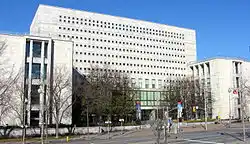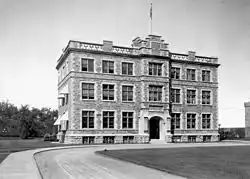
Library and Archives Canada is the largest repository in the world for Canadian genealogical information and studying family history in Canada. Although it was only established in its current format in 2004, the national archives in Canada date back in one form or another to 1872. It houses a really enormous body of demographic and governmental data and records like census records, passenger lists and immigration records, newspapers going back well in to the eighteenth century and much else besides. Many of these records have been digitized in recent years and millions of them are available through MyHeritage. The Library and Archives is a key repository to engage with for anyone tracing their ancestry and family history in Canada.[1]
Research your ancestors on MyHeritage
History of CanadaHistory of Canada
Library and Archives Canada hold records pertaining to the entire history of Canada. The country of Canada is a relatively modern construct, though there have been human beings in the region covered by the country for much longer. Canada was one of the first places in the western hemisphere populated by Homo sapiens, as it lies very near the frozen land bridge over the Bering Straits that humans used to cross from Eurasia to North America towards the end of the last Ice Age. Therefore the first humans arrived to Canada around 11,000 BCE.[2] Numerous different native peoples lived across what is the second largest country in the world. These had very different cultures produced by starkly different environments, with the Wendat and Mohawks of south-eastern Canada living much like the natives of the eastern seaboard of the United States, while much further to the north-west Inuit groups lived in the frozen tundra of Canada inside the Arctic Circle.[3]

Most of the records held by Library and Archives Canada date to the period since 1608 when Samuel de Champlain established Quebec City as the first major settlement of what would soon be termed New France. Over the next century and a half the French acquired a major colonial presence here in the south-eastern corner of Canada in the region along the course of the St Lawrence River between the Great Lakes and the Gulf of St Lawrence out towards Newfoundland and Acadia.[4]
Yet the French never engaged in colonization on the same scale as the English further to the south and by the middle of the eighteenth century French Canada’s colonial population was probably no more than 70,000 people, while the colonial population of the English Thirteen Colonies to the south had exceeded 1.5 million people. Perhaps unsurprisingly, given the demographic disparity, the British were able to defeat the French in North America during the French and Indian Wars (1754–1763), also known as the Seven Years’ War internationally (1756–1763), and when these came to an end in 1763 France ceded their Canadian colonies to Britain.[5]
Under British rule, colonial settlement in what increasingly became known as Canada instead of New France, expanded dramatically, especially so following the American Revolutionary War, when the emergence of the United States as an independent nation saw many British loyalists leave the Thirteen Colonies and settle in places like Acadia and Newfoundland. By 1800 the colonial population had swelled to around 400,000. In 1867 the provinces of Canada were granted a growing array of powers of self-determination from Britain as the provinces of Quebec, New Brunswick, Nova Scotia and Ontario joined together as the Dominion of Canada. Manitoba and the Northwest Territories joined the confederation three years later, followed by British Columbia in 1871, Prince Edward Island in 1873, the Yukon Territory in 1898 and Alberta in 1905.[6]
Throughout these decades large scale settlement in central and western Canada commenced for the first time, fueled by gold rushes and the advent of the railways. Provincial and municipal governments emerged all over the country and the provinces gradually began introducing civil registration. Finally, the first national census was conducted in 1871. All of this activity began the process whereby an immense array of demographic and governmental records were created in Canada. They soon needed a national library and archives service to house and manage them.[7]
Library and Archives CanadaLibrary and Archives Canada

The Library and Archives Canada, in its current manifestation, only dates to 2004. Ultimately, though, its origins can be traced all the way back to 1872 when the Dominion Archives were established to house the governmental records created by the newly formed Dominion of Canada. It was renamed as the Public Archives of Canada in 1912.[8] Over four decades later, in 1953, the National Library of Canada was set up as a national library, mirroring the foundation of other national libraries in former parts of the British Empire such as in Ireland and Wales in 1877 and 1907.[9]
In 2004, in line with a growing tendency in western countries to amalgamate national libraries and archives, the National Library of Canada and the Public Archives of Canada (known as National Archives of Canada since 1987) were joined together to form Library and Archives Canada. It houses an enormous collection of original records produced by the Canadian state over the last two centuries, both locally and nationally. The huge collections constitute, by some standards, the fifth largest library in the world, behind only the British Library in London, the Library of Congress in Washington D.C., Shanghai Library and New York Public Library. The institution is the world’s largest repository of data for Canadian genealogical studies.
Genealogical research at Library and Archives CanadaGenealogical research at Library and Archives Canada
The records for civil registration, such as birth, marriage and death records, known as vital records in Canada, are generally found in archives in the individual states or provinces of Canada. Therefore Library and Archives Canada is primarily a repository for the original records of national Canadian records such as national censuses. The Library and Archives have also become the repository for a wide array of records that were produced in Canada prior to the creation of the Dominion in 1867, notably local censuses and poll taxes, military records under British rule, passenger lists and other immigration records, many covering the century of direct British rule and some even extending back to the era of New France. Microfilms and other copies of records held in provincial archives are also often available in the Library and Archives headquarters in the city of Ottawa.[10] MyHeritage provides access to a very wide range of records such as the Canadian national censuses held since 1871 and further local censuses and poll taxes going back decades further under British rule.[11]
See alsoSee also
Explore more about genealogical research in CanadaExplore more about genealogical research in Canada
- Canada Directories records collection on MyHeritage
- 1851 Canada Census records collections on MyHeritage
- 1901 Canada Census records collection on MyHeritage
- 1931 Canada Census records collection on MyHeritage
- Canada Newspapers, 1752-2007 records collection on MyHeritage
- Canada, Burials, 1800-2019 records collection on MyHeritage
- How to Find Birth, Marriage and Death Registrations in Canada at Legacy Family Tree Webinars
- Tools to Research Your French Canadian Ancestors at Legacy Family Tree Webinars
References
- ↑ https://library-archives.canada.ca/eng
- ↑ https://www.livescience.com/archaeology/the-1st-americans-may-have-arrived-by-a-sea-ice-highway
- ↑ https://guides.loc.gov/quebec/indigenous-peoples
- ↑ https://www.thecanadianencyclopedia.ca/en/collection/new-france
- ↑ https://www.thecanadianencyclopedia.ca/en/article/seven-years-war
- ↑ https://www.thecanadianencyclopedia.ca/en/article/dominion
- ↑ https://www.bac-lac.gc.ca/eng/census/Pages/census.aspx
- ↑ A. G. Doughty and C. H. Firth, ‘The History of the Canadian Archives’, in Transactions of the Royal Historical Society, Vol. 9 (1915), pp. 167–174.
- ↑ https://www.thecanadianencyclopedia.ca/en/article/national-library-of-canada
- ↑ https://library-archives.canada.ca/eng/collection/research-help/genealogy-family-history/censuses/Pages/censuses.aspx
- ↑ https://library-archives.canada.ca/eng/collection/research-help/Pages/research-help.aspx

